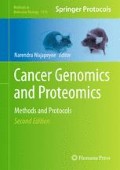Abstract
Disease related antigens are of great importance in the clinic. They are used as markers to screen patients for various forms of cancer, to monitor response to therapy, or to serve as therapeutic targets (Chapman et al., Ann Oncol 18(5):868–873, 2007; Soussi et al., Cancer Res 60:1777–1788, 2000; Anderson and LaBaer, J Proteome Res 4:1123–1133, 2005; Levenson, Biochim Biophy Acta 1770:847–856, 2007). In cancer endogenous levels of protein expression may be disrupted or proteins may be expressed in an aberrant fashion resulting in an immune response that bypasses self tolerance (Soussi et al., Cancer Res 60:1777–1788, 2000; Disis et al., J Clin Oncol 15(11):3363–3367, 1997; Molina et al., Breast Cancer Res Treat 51:109–119, 1998). Protein microarrays, which represent a large fraction of the human proteome, have been used to identify antigens in multiple diseases including cancer (Anderson and LaBaer, J Proteome Res 4:1123–1133, 2005; Disis et al., J Clin Oncol 15(11):3363–3367, 1997; Hudson et al., Proc Natl Acad Sci U S A 104(44):17494–17499, 2007; Beyer et al., J Neuroimmunol 242:26–32, 2012). Typically, arrays are probed with immunoglobulin (Ig) samples from patients as well as healthy controls, then compared to determine which antigens (Ag’s) are more reactive within the patient group (Hudson et al., Proc Natl Acad Sci U S A 104(44):17494–17499).
Access this chapter
Tax calculation will be finalised at checkout
Purchases are for personal use only
References
Ptacek J et al (2005) Global analysis of protein phosphorylation in yeast. Nature 438(7068): 679–684
Hudson M et al (2007) Identification of differentially expressed proteins in ovarian cancer using high-density protein microarrays. Proc Natl Acad Sci U S A 104(44):17494–17499
Beyer N et al (2012) Investigation of autoantibody profiles for cerebrospinal fluid biomarker discovery in patients with relapsing–remitting multiple sclerosis. J Neuroimmunol 242:26–32
Chen R et al (2012) Personalized omics profiling reveals dynamic molecular and medical phenotypes. Cell 148:1293–1307
Zhu H et al (2006) Severe acute respiratory syndrome diagnostics using a coronavirus protein array. Proc Natl Acad Sci U S A 103(11): 4011–4016
Scanlan M et al (2001) Humoral immunity to human breast cancer: antigen definition and quantitative analysis of mRNA expression. Cancer Immun 1:4
Qiu J et al (2011) Nucleic acid programmable protein array a just-in-time multiplexed protein expression and purification platform. Methods Enzymol 500:151–163
Carlsson A et al (2008) Serum proteome profiling of metastatic breast cancer using recombinant antibody microarrays. Eur J Cancer 44:472–480
Molina R et al (1998) c-erbB2 oncoprotein, CEA, and CA 15.3 in patients with breast cancer: prognostic value. Breast Cancer Res Treat 51:109–119
Levenson V (2007) Biomarkers for early detection of breast cancer: what, when, and where? Biochim Biophys Acta 1770:847–856
Disis M et al (1997) High-titer HER-2/neu protein-specific antibody can be detected in patients with early-stage breast cancer. J Clin Oncol 15(11):3363–3367
Cho W (2007) Contribution of oncoproteomics to cancer biomarker discovery. Mol Cancer 6(25):1–13
Zhu X et al (2006) ProCat: a data analysis approach for protein microarrays. Genome Biol 7:R110
Author information
Authors and Affiliations
Corresponding author
Editor information
Editors and Affiliations
Rights and permissions
Copyright information
© 2014 Springer Science+Business Media New York
About this protocol
Cite this protocol
Sharon, D., Snyder, M. (2014). Serum Profiling Using Protein Microarrays to Identify Disease Related Antigens. In: Wajapeyee, N. (eds) Cancer Genomics and Proteomics. Methods in Molecular Biology, vol 1176. Humana Press, New York, NY. https://doi.org/10.1007/978-1-4939-0992-6_14
Download citation
DOI: https://doi.org/10.1007/978-1-4939-0992-6_14
Published:
Publisher Name: Humana Press, New York, NY
Print ISBN: 978-1-4939-0991-9
Online ISBN: 978-1-4939-0992-6
eBook Packages: Springer Protocols

